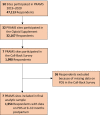Timing of Postpartum Depressive Symptoms
- PMID: 37943725
- PMCID: PMC10684283
- DOI: 10.5888/pcd20.230107
Timing of Postpartum Depressive Symptoms
Abstract
Introduction: Postpartum depression is a serious public health problem that can adversely impact mother-child interactions. Few studies have examined depressive symptoms in the later (9-10 months) postpartum period.
Methods: We analyzed data from the 2019 Pregnancy Risk Assessment Monitoring System (PRAMS) linked with data from a telephone follow-up survey administered to PRAMS respondents 9 to 10 months postpartum in 7 states (N = 1,954). We estimated the prevalence of postpartum depressive symptoms (PDS) at 9 to 10 months overall and by sociodemographic characteristics, prior depression (before or during pregnancy), PDS at 2 to 6 months, and other mental health characteristics. We used unadjusted prevalence ratios (PRs) to examine associations between those characteristics and PDS at 9 to 10 months. We also examined prevalence and associations with PDS at both time periods.
Results: Prevalence of PDS at 9 to 10 months was 7.2%. Of those with PDS at 9 to 10 months, 57.4% had not reported depressive symptoms at 2 to 6 months. Prevalence of PDS at 9 to 10 months was associated with having Medicaid insurance postpartum (PR = 2.34; P = .001), prior depression (PR = 4.03; P <.001), and current postpartum anxiety (PR = 3.58; P <.001). Prevalence of PDS at both time periods was 3.1%. Of those with PDS at both time periods, 68.5% had prior depression.
Conclusion: Nearly 3 in 5 women with PDS at 9 to 10 months did not report PDS at 2 to 6 months. Screening for depression throughout the first postpartum year can identify women who are not symptomatic early in the postpartum period but later develop symptoms.
Figures


References
-
- van Dijk MT, Murphy E, Posner JE, Talati A, Weissman MM. Association of multigenerational family history of depression with lifetime depressive and other psychiatric disorders in children: results from the Adolescent Brain Cognitive Development (ABCD) study. JAMA Psychiatry. 2021;78(7):778–787. 10.1001/jamapsychiatry.2021.0350 - DOI - PMC - PubMed
-
- Trost S, Beauregard J, Chandra G, Njie F, Berry J, Harvey A, et al. Pregnancy-Related Deaths: Data From Maternal Mortality Review Committees in 36 US States, 2017–2019. Centers for Disease Control and Prevention, US Department of Health and Human Services; 2022. Accessed September 22, 2022. https://www.cdc.gov/reproductivehealth/maternal-mortality/docs/pdf/Pregn...
MeSH terms
LinkOut - more resources
Full Text Sources
Medical
Research Materials
Miscellaneous

